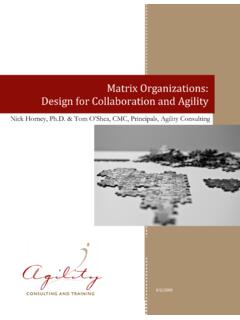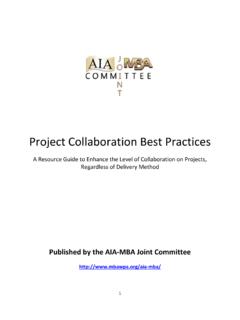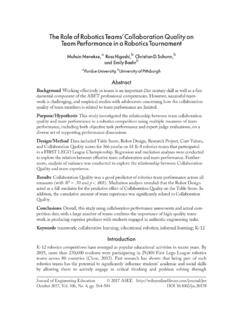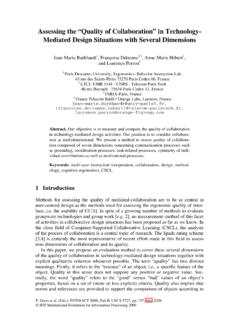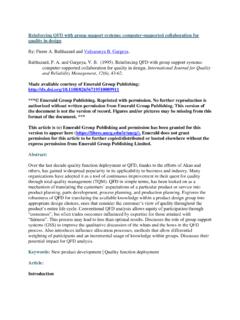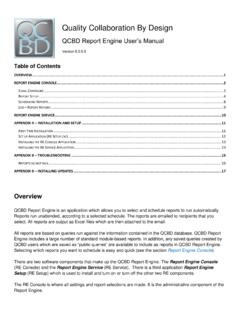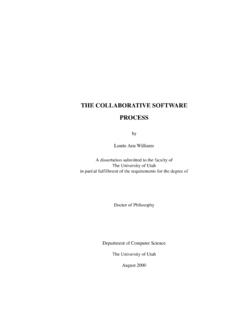Transcription of Data Collection Checklist - Cochrane
1 Cochrane Effective Practice and Organisation of Care Review Group data Collection Checklist Page 2 Cochrane Effective Practice and Organisation of Care Review Group (EPOC) data Collection Checklist CONTENTS Item Page Introduction 5-6 1 Inclusion criteria* 7-8 Study design * 7 Randomised controlled trial* Controlled clinical trial* Controlled before and after study* Interrupted time series* Methodological inclusion criteria* 8 2 Interventions* 9-12 Type of intervention 9 Professional interventions* 9 Financial interventions* 10 Provider
2 Interventions* Patient interventions* Organisational interventions* 11 Provider orientated interventions* Patient orientated interventions* Structural interventions* Regulatory interventions* 12 Controls* 13 3 Type of targeted behaviour* 13 4 Participants* 14-15 Characteristics of participating providers* 14 Profession* Item Page Page 3 Level of training* Clinical speciality* Age Time since graduation Characteristics of participating patients* 15 Clinical problem* Other patient characteristics Number of patients included in the study* 5 Setting* 16 Reimbursement system Location of care* Academic Status* Country* Proportion of eligible providers from the sampling frame* 6 Methods* 17 Unit of allocation* Unit of analysis* Power
3 Calculation* quality criteria* 17-22 quality criteria for randomised controlled trials (RCT) and controlled clinical trials (CCT)* 17 quality criteria for controlled before and after (CBA) designs* 19 quality criteria for interrupted time series (ITS) designs* 20 Consumer involvement* 22 7 Prospective identification by investigators of barriers to change 22 8 Intervention* 23-25 Characteristics of the intervention* 23 Page 4 Item Page Nature of desired change Format Source 24 Intervention based upon implementation of clinical practice guidelines Clinical practice guidelines developed through formal consensus process Recipient Deliverer Timing 25 Setting of intervention Source of
4 Funding Ethical approval 9 Outcomes* 26 Description of the main outcome measure(s)* Length of time during which outcomes were measured after initiation of the intervention* Length of post-intervention follow-up period* Possible ceiling effect* 10 Results* 27-28 Randomised controlled trials and controlled clinical trials* Controlled before and after designs* Interrupted time series* For items marked with *, please see introduction on page 5. Revised by Laura McAuley with input from Craig Ramsay.
5 June 2002. Page 5 Checklist Cochrane Effective Practice and Organisation of Care Review Group (EPOC) Cochrane Effective Practice and Organisation of Care Group (EPOC) Institute of Population Health, University of Ottawa 1 Stewart St. Ottawa, Ontario, Canada K1N 6N5 Alain Mayhew, Review Group Co-ordinator Tel: (613) 562-5800 ext 2361 Fax: (613)562-5659 E-mail: or INTRODUCTION The purpose of the data extraction Checklist is to provide a guide to reviewers about the type of relevant information that could be extracted from primary studies. Each review is different and reviewers will need to adapt the Checklist to suit their purposes. In order to make reviews useful to readers, certain types of information (for example quality assessments) should be available in all reviews.
6 These standard items are marked with an asterisk (*). METHODS Once relevant studies have been identified for possible inclusion in a review, data regarding inclusion criteria ( design , participants, interventions, and outcomes), quality criteria and results should be extracted independently by two reviewers. Other data can be extracted by one reviewer and checked by another. Reviewers should consider how data will be presented in the appropriate software, Review Manager (RevMan). Examples of the Table of Included Studies, and Results Tables are available from the editorial office. These examples illustrate the standard format used by EPOC. Prior to entering data into RevMan, reviewers should check with their assigned contact editor.
7 Paper or electronic forms Reviewers may choose from a number of different options to record data extraction, including the EPOC data Collection template (available in paper and electronic format) and an Idealist database (available from the Blackwell publishing group), incorporating the group s register definition file which is available from the editorial office. Choice of format for data Collection will depend upon strategies used for checking data . Reviewers should be aware that data tables created using word processing software cannot be readily transferred into RevMan (at present). If reviewers enter data directly into RevMan, then reviews should be exported frequently for safekeeping. During data Collection , it may be useful for reviewers to indicate the source page numbers against each item recorded as this facilitates later comparisons of extracted data .
8 Discrepancies between reviewers should be resolved by discussion and any decisions that cannot be resolved easily should be referred to the contact editor for the review. Page 6 Checklist data that is missing or not clear in a published report should be marked clearly on the data Collection form. Missing information should be sought from the corresponding author of a paper. Page 7 Checklist 1. INCLUSION CRITERIA The items - (inclusive) in this section determine whether a study should be included in an EPOC review. Study design The design of the study is (state which): Randomised controlled trial (RCT) a trial in which the participants (or other units) were definitely assigned prospectively to one or two (or more) alternative forms of health care using a process of random allocation ( random number generation, coin flips).
9 Controlled clinical trial (CCT) may be a trial in which participants (or other units) were: a) definitely assigned prospectively to one or two (or more) alternative forms of health care using a quasi-random allocation method ( alternation, date of birth, patient identifier) or; b) possibly assigned prospectively to one or two (or more) alternative forms of health care using a process of random or quasi-random allocation. Controlled before and after study (CBA) involvement of intervention and control groups other than by random process, and inclusion of baseline period of assessment of main outcomes. There are three minimum criteria for inclusion of CBAs in EPOC reviews: a) Contemporaneous data Collection Score DONE pre and post intervention periods for study and control sites are the same.
10 Score NOT CLEAR if it is not clear in the paper, dates of Collection are not mentioned in the text. ( the paper should be discussed with the contact editor for the review before data extraction is undertaken). Score NOT DONE if data Collection was not conducted contemporaneously during pre and post intervention periods for study and control sites. b) Appropriate choice of control site: Studies using second site as controls: Score DONE if study and control sites are comparable with respect to dominant reimbursement system, level of care, setting of care and academic status. Score NOT CLEAR if not clear from paper whether study and control sites are comparable. ( the paper should be discussed with the contact editor for the review before data extraction is undertaken).


